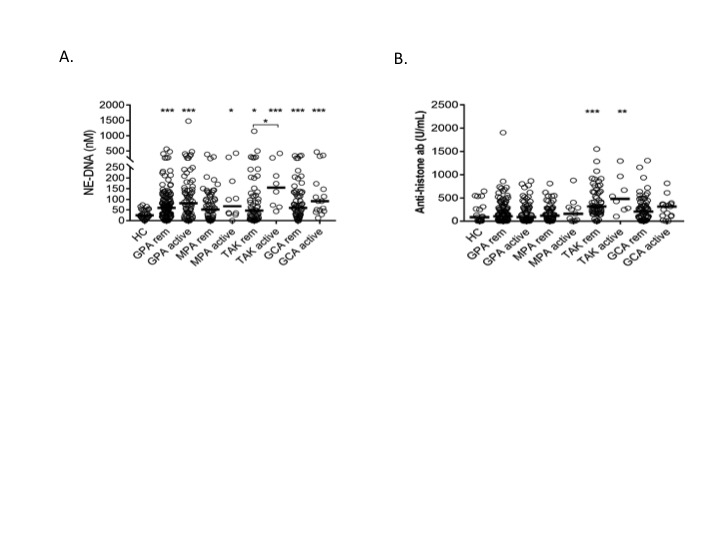Session Information
Date: Tuesday, November 9, 2021
Title: Vasculitis – Non-ANCA-Associated & Related Disorders Poster II (1862–1888)
Session Type: Poster Session D
Session Time: 8:30AM-10:30AM
Background/Purpose: Neutrophil extracellular trap (NET) formation, the extrusion of chromatin and granular components from activated neutrophils, is essential in host defense. However, NET formation has also been linked to inflammation and autoimmunity, including in anti-neutrophil cytoplasmic autoantibody (ANCA)-associated vasculitis (AAV), a disease of small blood vessels. Neutrophil infiltration is seen in aortic specimens of patients with Takayasu’s arteritis (TAK) and affected arteries of giant cell arteritis (GCA), two types of large-vessel vasculitis (LVV). Whether NET formation and autoimmunity against NET antigens such as extracellular histones, a common NET-related autoantigen in other autoimmune diseases including systemic lupus erythematosus and rheumatoid arthritis, occurs in LVV is not known. The purpose of this study was to compare levels of NET formation and anti-histone antibodies across different types of vasculitis.
Methods: Plasma levels of NETs (neutrophil elastase (NE)-DNA complexes) and anti-histone antibodies were analyzed in healthy controls (n=30), and patients with AAV (granulomatosis with polyangiitis (GPA, n=196), microscopic polyangiitis (MPA, n=74)), TAK (n=66), and GCA (n=82), at times of remission or flare. Disease activity was assessed using physician global assessments (PGA).
Results: Compared to healthy controls (HC) NE-DNA complexes were significantly elevated in all patients with vasculitis, both at flare and remission, except at remission for patients with MPA (Figure 1A). In patients with TAK, but none of the other conditions, elevated levels of NE-DNA complexes were seen at time of flare as compared to remission (p< 0.05), with NE-DNA levels correlating with PGA (r=0.28, p< 0.05). Levels of NETs did not correlate with C-reactive protein, a marker of general inflammation. Only patients with TAK had significantly higher levels of anti-histone antibodies in their circulation regardless of disease activity (p< 0.01) (Figure 1B). In patients with TAK, levels of anti-histone antibodies correlated with presence of NETs (r=0.35, p< 0.01).
Conclusion: NET formation, as assessed by NE-DNA complexes, is elevated in both small- and large-vessel vasculitis, suggesting a potential common disease link across vasculitides. The association of anti-histone antibodies with NETs in TAK suggests NETs may be a source of autoantigens in this disease. Further studies are needed to explore the role of NETs and anti-histone antibodies in the pathogenesis of vasculitis.
 Figure 1. Levels of NE-DNA complexes and anti-histone antibodies in patients with vasculitis. Levels of A) NE-DNA complexes and B) anti-histone antibodies were analyzed in healthy controls (HC), and patients with vasculitis at times of remission (rem) and active disease. Statistical analyses were done by Mann-Whitney U test with *p < 0.05, **p < 0.01 and ***p < 0.001. Unless otherwise indicated, all analyses are compared to healthy controls. Each circle represents an individual sample, with the bar representing the median of the group. GPA: granulomatosis with polyangiitis; MPA: microscopic polyangiitis; TAK: Takayasu’s arteritis; GCA: giant cell arteritis.
Figure 1. Levels of NE-DNA complexes and anti-histone antibodies in patients with vasculitis. Levels of A) NE-DNA complexes and B) anti-histone antibodies were analyzed in healthy controls (HC), and patients with vasculitis at times of remission (rem) and active disease. Statistical analyses were done by Mann-Whitney U test with *p < 0.05, **p < 0.01 and ***p < 0.001. Unless otherwise indicated, all analyses are compared to healthy controls. Each circle represents an individual sample, with the bar representing the median of the group. GPA: granulomatosis with polyangiitis; MPA: microscopic polyangiitis; TAK: Takayasu’s arteritis; GCA: giant cell arteritis.
To cite this abstract in AMA style:
Michailidou D, Kuley R, Mustelin T, Cuthbertson D, Grayson P, Khalidi N, KOENING C, Langford C, McAlear C, Moreland L, Pagnoux C, Seo P, Specks U, Sreih A, Warrington K, Monach P, Merkel P, Lood C. Neutrophil Extracellular Trap Formation in Patients with Vasculitis [abstract]. Arthritis Rheumatol. 2021; 73 (suppl 9). https://acrabstracts.org/abstract/neutrophil-extracellular-trap-formation-in-patients-with-vasculitis/. Accessed .« Back to ACR Convergence 2021
ACR Meeting Abstracts - https://acrabstracts.org/abstract/neutrophil-extracellular-trap-formation-in-patients-with-vasculitis/
